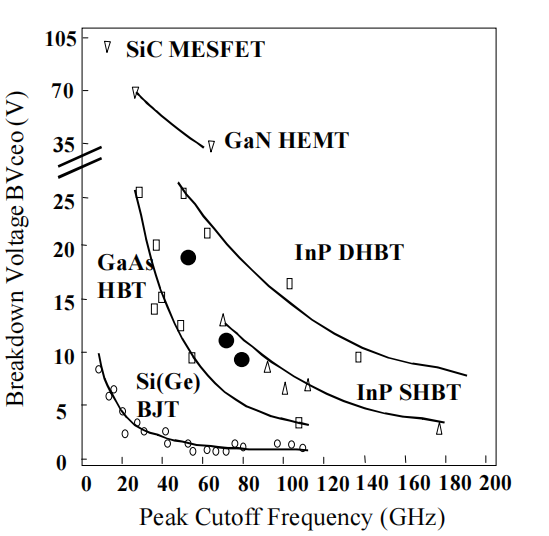ABSTRACT
GaAs HBT technology is being challenged for existing and new product applications. SiC FETs and GaN HEMTs have been shown to have significant power delivery advantage when large supply voltages are required. InP HBTs are emerging as the next technology for very high-speed applications. After years of promise and controversy, the SiGe HBT is beginning to be applied in high-performance systems. Part of this success is due to an improved understanding of on-chip silicon-based passive components and isolation capability. As an example, a 10GB/s limiting amplifier is described. Although one is forced to acknowledge that silicon-based design is now capable of very high-speed performance, it is important to recognize GaAs HBTs continue to dominate extended-voltage / power applications. There are many examples of this in the wireless area. A 5V GaAs modulator driver chip is provided as an example in this paper. At this time there are numerous potential GaAs HBT challengers, however, only SiGe HBT’s appear ready for large volume, cost competitive deployment in both bipolar and BiCMOS variants.
INTRODUCTION
The selection of high-performance, compound semiconductor technology is increasingly diverse. The historical mainstay of the industry, GaAs, is continually being challenged for existing and new product applications. A partial list of challengers includes SiC FETs and GaN HEMTs for power delivery, InP HBTs for very high-speed and lowpower analog-digital applications, and SiGe HBTs where high levels of integration and low-power are requirements. The later can also be combined with CMOS providing the potential for system-on-a-chip solutions. Although not compound semiconductors, there have been significant strides in silicon LDMOS and homojunction bipolar transistors recently. It is also notable that deep sub-micron CMOS has Ft, Fmax and noise performance to rival some currently available compound semiconductor technology. All this in the context of GaAs technology continuing to improve in performance, cost and manufacturability. In addition, the availability of high-performance semiconductor technology has improved considerably in recent years as the thirst for commercial bandwidth increases. Once the exclusive domain of the military, new commercial data centric applications in both wireless and fiber-based product now require the high levels of performance offered by these technologies. These conditions have made the taskof choosing the most appropriate technology for product applications more difficult. This paper will focus primarily on the challenges to GaAs HBT technology, and will begin with a review of selected performance characteristics of available active components. An additional requirement for good highperformance design is the correct use of passive components and on-chip isolation techniques. These have long been the exclusive territory of III-V technology. However, siliconbased passives and isolation have improved recently, and as such, will be discussed. Both contribute to the ability to integrate analog-digital functions on a single chip in order to reduce high-performance packaging complexity, and therefore cost. Two 10GB/s datacom circuit blocks will be described in order to place performance capabilities in context. Finally, an attempt will be made to estimate the time when manufacturable versions of these technologies will be available.
INTRODUCTION
The selection of high-performance, compound semiconductor technology is increasingly diverse. The historical mainstay of the industry, GaAs, is continually being challenged for existing and new product applications. A partial list of challengers includes SiC FETs and GaN HEMTs for power delivery, InP HBTs for very high-speed and lowpower analog-digital applications, and SiGe HBTs where high levels of integration and low-power are requirements. The later can also be combined with CMOS providing the potential for system-on-a-chip solutions. Although not compound semiconductors, there have been significant strides in silicon LDMOS and homojunction bipolar transistors recently. It is also notable that deep sub-micron CMOS has Ft, Fmax and noise performance to rival some currently available compound semiconductor technology. All this in the context of GaAs technology continuing to improve in performance, cost and manufacturability. In addition, the availability of high-performance semiconductor technology has improved considerably in recent years as the thirst for commercial bandwidth increases. Once the exclusive domain of the military, new commercial data centric applications in both wireless and fiber-based product now require the high levels of performance offered by these technologies. These conditions have made the task

DEVICE PERFORMANCE
Transistors Semiconductor electronic devices can be divided into roughly two categories; power and speed. There are numerous variations on these themes, including low-noise, as well as integration of additional functionality. One view of how each of the device technologies fit into this categorization is to plot peak cutoff frequency (Ft) vs. breakdown voltage (BV), Figure 1
Each of these devices is capable of delivering reasonably efficient power into an antenna, particularly in the 2GHz band. Table 1 summarizes representative power density results at 2GHz. Current cellular phones are dependent on GaAs (HBT) technology for power amplification, as they are capable withstanding supply voltages of ≥5Volts, while tolerating large VSWR mismatch. The primary difference between these technologies is stand-off voltage capability, production maturity notwithstanding. The 0.8 um SiC MESFET demonstrates the largest breakdown voltage at 105V. This device yielded 2.8W/mm, class A using a supply voltage of 40V. The 0.3um GaN HEMT demonstrated a breakdown voltage of 35 volts [1]. 4.2 W/mm was achieved using a supply voltage of 10V at a channel temperature approaching 125C. This result is all the more impressive as it was achieved using sapphire substrates. SiC substrates, with their superior thermal performance should serve to improve power densities considerably.